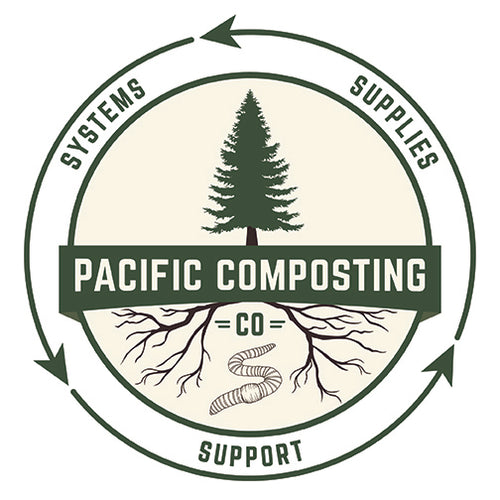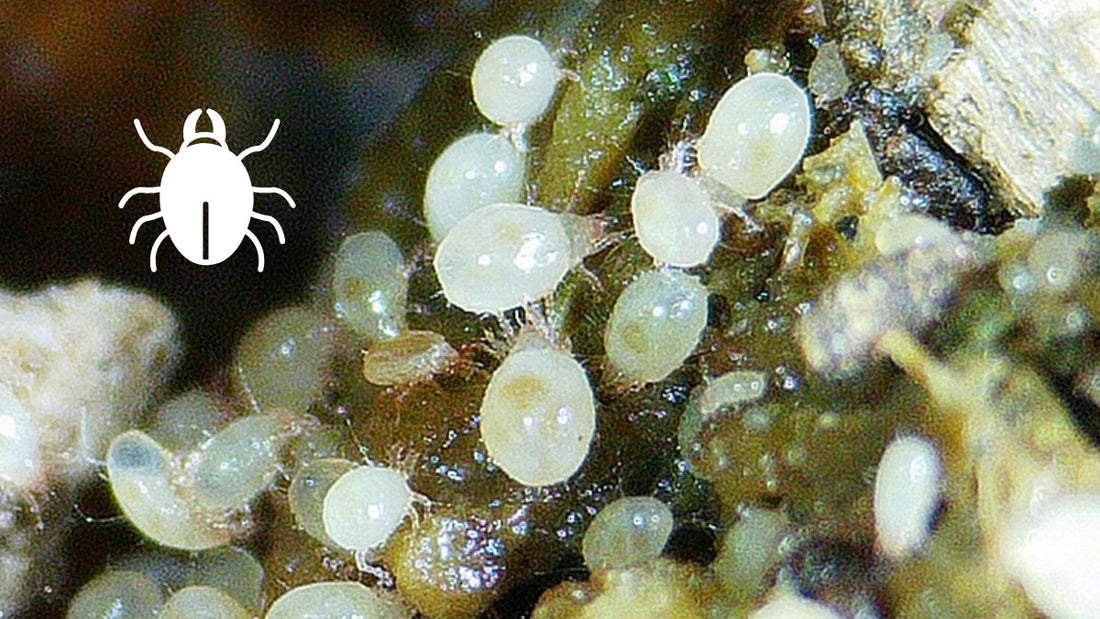New vermicomposters, even the eager beaver readers who have studied the topic extensively, often end up dismayed by the incredible array of other creatures (apart from their precious worms) that show up in their worm bin.
Mites are one of the most common organisms to make their presence known in vermicomposting systems, sometimes in great abundance.
In this installment of our ongoing critter series we’ll unpack the WHATs, WHYs, and HOWs of these interesting invertebrates!
Mites are small (often very tiny), unsegmented arthropods, more closely related to spiders than insects. Although they tend to be mostly under-the-radar as far as humans are concerned, they are represented in just about every ecological niche imaginable.
Here is a breakdown of mite classification:
Phylum: Arthropoda
Subphylum: Chelicerata
Class: Arachnida
Superorder: Acariformes
Superorder: Parasitiformes
The superorder Parasitiformes includes ticks, and other well-known parasites such as Varroa Mites - but rest assured, the mites you find in a vermicomposting system are NOT the types that are going to pose any sort of threat to you, your pets, your plants or your home!
Worm bin mites, just like the vast majority of other organisms you find in a composting system, are primarily adapted for that ecosystem.
There is one small (quite literally) exception we’ll get to in a minute, but even that one likely isn’t something you need to be overly concerned about.
—
In vermicomposting systems, there are probably 4 main groups of mites you are likely to encounter - two of them a lot more common (and obvious) than the others.
As important as scientific names can be for invertebrate identification, in the case of mites we can likely get by perfectly fine with common names / general descriptions; partly because there isn’t a lot of “worm bin mite classification” info out there, but mainly because the causes and “cures” for the main varieties are largely the same.
White Mites

The most common “white mite” found in vermicomposting systems is often mistaken for some type of egg. They tend to be very oval in shape, shiny in appearance, and have very slow movement. You will often find them congregated on wet food materials, but if you end up with a significant outbreak, you will likely find lots of them on the bedding, walls and underside of your lid as well.
At times you may even observe these mites on top of your worms. Assuming this isn’t simply because there are a lot of them in the system, they are most likely just scavenging dead (or nearly dead) worms. If you are finding a lot of sickly looking worms coated in white mites, there is almost always something else going on in the system that’s actually harming the worms. The mites themselves don’t attack healthy worms; they are more like little worm bin “vultures”, simply taking advantage of available resources, and (importantly) helping you to keep the system cleaned up!
Brown Mites

This is another very common group of mites in worm bins. The colour and (often) somewhat smaller size tends to make them more inconspicuous than white mites, but in certain cases they can definitely make their presence known (we will circle back to common causes of mite outbreaks further along).
Like white mites, these guys are fairly slow moving and, to the untrained eye, they may just look like shiny brown dots on your food materials.
Flour/Grain Mites

It is less common to encounter these in a typical worm bin, but in somewhat drier systems, especially ones that receive baking wastes (bread etc) and/or dry animal feeds, it is more common to find them. That said, they are actually very difficult to detect with the naked eye when living in their foods of choice. What you may see in a damp system, though, is what looks like fine dust on the side walls or underside of the lid.
In rare cases, you may see heavier concentrations near ventilation holes (similar to pictured below) - maybe even on the outside of the bin.
The good news is that, while these mites do have more potential for being a pest in your home, unless your worm bin is in your pantry, or at least very close to accessible dry goods, it’s unlikely they will survive for long enough in your home to reach another food source.

Predatory Mites

This group of mites tends to be a lot less abundant in worm bins than the common white or brown mites, but they are beneficial when present, so it’s worth including them in this discussion.
In terms of appearance and other characteristics, predatory mites tend to have longer legs and move a lot more quickly than the common varieties of mites we’ve looked at.
The main benefit of predatory mites lies in their ability to keep populations of other invertebrates, such as springtails and small fly larvae in check. One variety very commonly used as a biological control agent in greenhouses - primarily for control of fungus gnat larvae - is Stratiolaelaps scimitus (formerly known as Hypoaspis miles).
What Leads to Mite Outbreaks?
Firstly, we recommend viewing outbreaks of any particular organism (including mites) in your systems more as an indicator of particular conditions and available resources, than as a threat. This is a much more helpful perspective, since it gets us focusing more on the source of the “problem” rather than on the symptoms.
Almost always, the most significant cause of worm bin invertebrate outbreaks is an excessive food supply.
This is a big part of why we always encourage feeding your worms in moderation, and basing your worm-feeding habits more on worm food consumption than on any specific worm-feeding stats (e.g. “worms can eat their weight in food per day”), or the amount of scraps you happen to have available.
Ways to Help Get Your System Back on Track
-
Remove excess foods and reduce the amount you are adding - Like we said, too much food is almost always the main culprit when it comes to population explosions of various critters. When you remove a lot of the excess food, and seriously cut back on the amounts you are adding, this alone can greatly reduce their ability to grow in number.
-
Add more bedding materials - Bedding serves as a habitat-enhancer and long-term food source for your composting worms, but it doesn’t offer any real benefits for organisms like mites. It serves to wick up excess moisture, often helps to improve airflow, and doesn’t offer the mites a source of nutrition.
-
Improve airflow - Open vermicomposting systems like CFTs very often don’t have obvious populations of mites in them (unlike enclosed plastic worm bins) because mites tend not to thrive nearly as well in drier, well-ventilated environments. You might consider leaving your worm bin lid off for periods of time, or even permanently (just make sure you have a nice thick layer of cover bedding in there), or simply drilling more air holes in the sides and lid of your container.
-
Mix in some living materials - If you happen to have a nice source of old horse manure or decomposed leaf litter, we recommend adding some to your system periodically. It’s a great overall habitat enhancer that helps to balance out the ecosystem, decreasing the chances of any one organism getting out of control.
-
Periodically add calcium-rich rock dusts or other buffers - Mites tend to thrive in fairly acidic environments. By adding some buffering materials (like our pH Buffer/Grit) every now and again, you can help to keep the pH more balanced.
Removing Mites From Your System (Optional)
Generally, the strategies just listed will lead to a re-balancing of a worm bin and a major decline in your (scavenger) mite populations. If you want to help the process along, however, you can also remove excess mites manually by luring them with tempting food items. Start by placing water-rich food scraps, such as melon slices, in the system. Leave them to sit for a period of time (long enough for them to get coated in mites), and then simply rinse off the mites (into outdoor composting systems etc) with water before repeating the process.
NOTE: This should not be used as a standalone strategy. As long as the mites still have a large supply of food and favourable conditions, they will likely continue to thrive.
Summing Up
- Mites are an extremely widespread invertebrate, occupying nearly every ecological niche on earth.
- Certain groups of mites can be very common in worm bins, but are usually not something we should be overly concerned about.
- Most of them are beneficial in that they help to perform a “clean-up” function, but population explosions can indicate that conditions in the system are out of balance.
- Poor airflow, high moisture levels, and overfeeding (especially water-rich wastes) are 3 of the most common contributing factors for mite outbreaks.
- Removing excess food (and cutting back on feeding), improving airflow, adding more bedding, adding more living material, and adding buffers can all help to re-balance your system.
Other Articles You May Be Interested In
An Introduction to Worm Bin (Macro) Invertebrates
Springtails - White Plague or Worm Ally?
How to Feed Your Worms to Get The Best Results From Your Worm Bin
Smelly Worm Bins - Possible Causes & Effective Solutions
What Is “Living Material”?
Bedding - The Most Important Material in Your Worm Bin?
DIY Plastic Worm Composting Bins
Recommended Products
Hemp Worm Blanket
Red Wigglers
Worm Starter Kit
Worm Rake
pH Buffer Grit
BioChar

